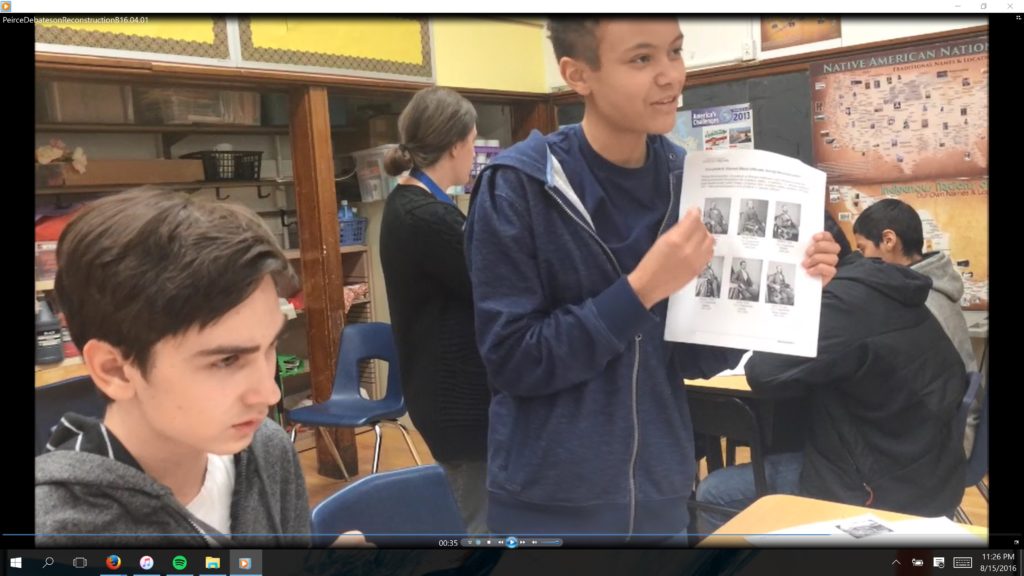
Video in on Table Debates on the Reconstruction Era, Part 2
This video-based isolation and analysis of six elements essential to the effective performance and implementation of classroom debating picks up from the prior Debatifier post (part 1), which covered three of the six:
1 . Organized, discrete argumentative claims
2 . Authoritative administration of simultaneous debating
3 . Responsive refutation
We’ll use the same format for the 4th through 6th elements: show a video clip featuring a successful practice and follow it with a spate of analysis. These clips come from the spring quarter implementation of an argument-centered unit on the Reconstruction Era at Helen C. Peirce School of International Studies in Chicago. The issue that organized the unit, and that framed the debates, was
Did the Reconstruction Era move African-Americans substantially closer to gaining equal rights and freedoms.
So, on to the “back three” elements essential to successful classroom debating.
4. Argument tracking (also called “flowing”)
This clip highlights how intently and intensively the students are tracking the arguments being made by their debate opponents, using their ACE-provided tracking forms (or “flow sheets,” in debate parlance). These “flow sheets” have separate columns for each segment of this (common) format of classroom debate — one for the opening arguments, one for the counter-arguments, and one for the rebuttals to the counter-arguments.
At the first table we observe the boy in the gray hoodie deftly moving between his flow sheet and the documents he is drawing on for evidence to support his claims and analyze the argumentative clash. He is illustrating that in effective academic debating the flow sheet not only records the other side’s arguments, it is also the site for notes for one’s own arguments, often in response to what the other side has said. In this way, a flow sheet is a site of written summaries of others’ arguments and of written formulation of one’s own arguments.
At the second table the boy in the blue shirt is arguing emphatically as both students on the opposing side demonstrate an urgency in their efforts to summarize the content of his claims and the analysis and support that he offers to back them up. These students — all of the students shown in this clip, across the classroom, in fact, including students at the third table, debating the effect of the Black Codes on the Reconstruction and its promises of equality — demonstrate a deeply assimilated understanding of the crucial role of argument tracking in rigorous academic argument, even so early in their academic careers!
5. Refutation that focuses on analysis of evidence
 Refutation that is college-directed comprises not only responsiveness, but comprehensiveness and depth of thinking, too. This clip depicts a student performing these additional two criteria for effective and advanced (or advancing) argumentative refutation.
Refutation that is college-directed comprises not only responsiveness, but comprehensiveness and depth of thinking, too. This clip depicts a student performing these additional two criteria for effective and advanced (or advancing) argumentative refutation.
The student in the blue hoodie spends most of her rebuttal addressing her opponent’s arguments by focusing on evidence — whose evidence is better, more thorough, more encompassing, more (as lawyers say) “dispositive” (i.e., capable of resolving the conflict by being definitive). In refuting her opponent’s argument that African-Americans had their voting rights infringed upon by the Black Codes, she cites documentary evidence that there were, for the first time in American history, black representatives in the U.S. Congress, in fact 17 of them, during the Reconstruction Era. She doesn’t go as far with her reasoning to analyze this evidence as she might have, and so she reveals a more limited “depth of thinking” than is exemplary. But what she is implying, or describing on the margins, is that the breakthrough fact of black representation in the nation’s chief legislative body, is a more definitive form of proof that African-Americans’ equality was substantially advanced relative to the period prior to Reconstruction than her opponent’s point that the Black Codes attempted to limit that freedom.
Earlier in her rebuttal she demonstrates an effort to achieve “comprehensiveness” in her refutation by attempting to evaluate the other side’s evidence. Again, her analysis is somewhat too thin, but she does say that the other side’s evidence that poll testing was an incursion on African-Americans’ right to vote isn’t sufficient to prove that those poll tests were significant enough in scale or scope to completely mitigate the impact of the 14th and 15th Amendments. She demonstrates an understanding that to be comprehensive in their refutation, a student must address the forcefulness and impact of the other side’s evidence. Addressing and analyzing evidence is at the heart of refutation, which in turn is at the center of the elevated platform that academic argumentation gives to thinking critically.
6. Debating to learn (or, Deepening content knowledge and understanding by making arguments and listening closely to the arguments of others)
 There are those who fear that academic argumentation and debate tend to reinforce students’ initial positions, that instead of achieving a kind of reconciliation of opposed sides or a synthesis of the true points into a higher truth academic debate polarizes. Dr. Gordon Mitchell calls this the “boomerang effect,” in a recent post in the Debatifier. (In that post’s second part, Dr. Mitchell identifies and elucidates three strategies by which refutation can overcome the “boomerang effect.”)
There are those who fear that academic argumentation and debate tend to reinforce students’ initial positions, that instead of achieving a kind of reconciliation of opposed sides or a synthesis of the true points into a higher truth academic debate polarizes. Dr. Gordon Mitchell calls this the “boomerang effect,” in a recent post in the Debatifier. (In that post’s second part, Dr. Mitchell identifies and elucidates three strategies by which refutation can overcome the “boomerang effect.”)
But this short clip demonstrates that for 6th – 12th grade students academic debating is far more likely to open their eyes and minds to ideas and points of view that they wouldn’t have fully understood without having to confront and to try to deeply understand them. This clip also shows that students often have their own views modified or changed entirely by engaging in argumentation and debate about important academic issues. Dr. Cathy Birkenstein, along with her They Say, I Say co-author Dr. Gerald Graff, tease out and then underline this crystal clear example of debate’s power to deepen students’ content knowledge and understanding by having to make arguments and listen closely to the arguments of others.
Dr. Birkenstein said after their school visit — in conjunction with the on-site professional development and implementation support services to its partner schools — that this entire series of classroom debates displayed a more impressively college-directed and higher-order level of student thinking, speaking, and writing than she had ever witnessed at the middle school level. A fitting tribute to the work of Mr. Lambert and Ms. Brugman, and to the commitment of Peirce International School to academic argument.


